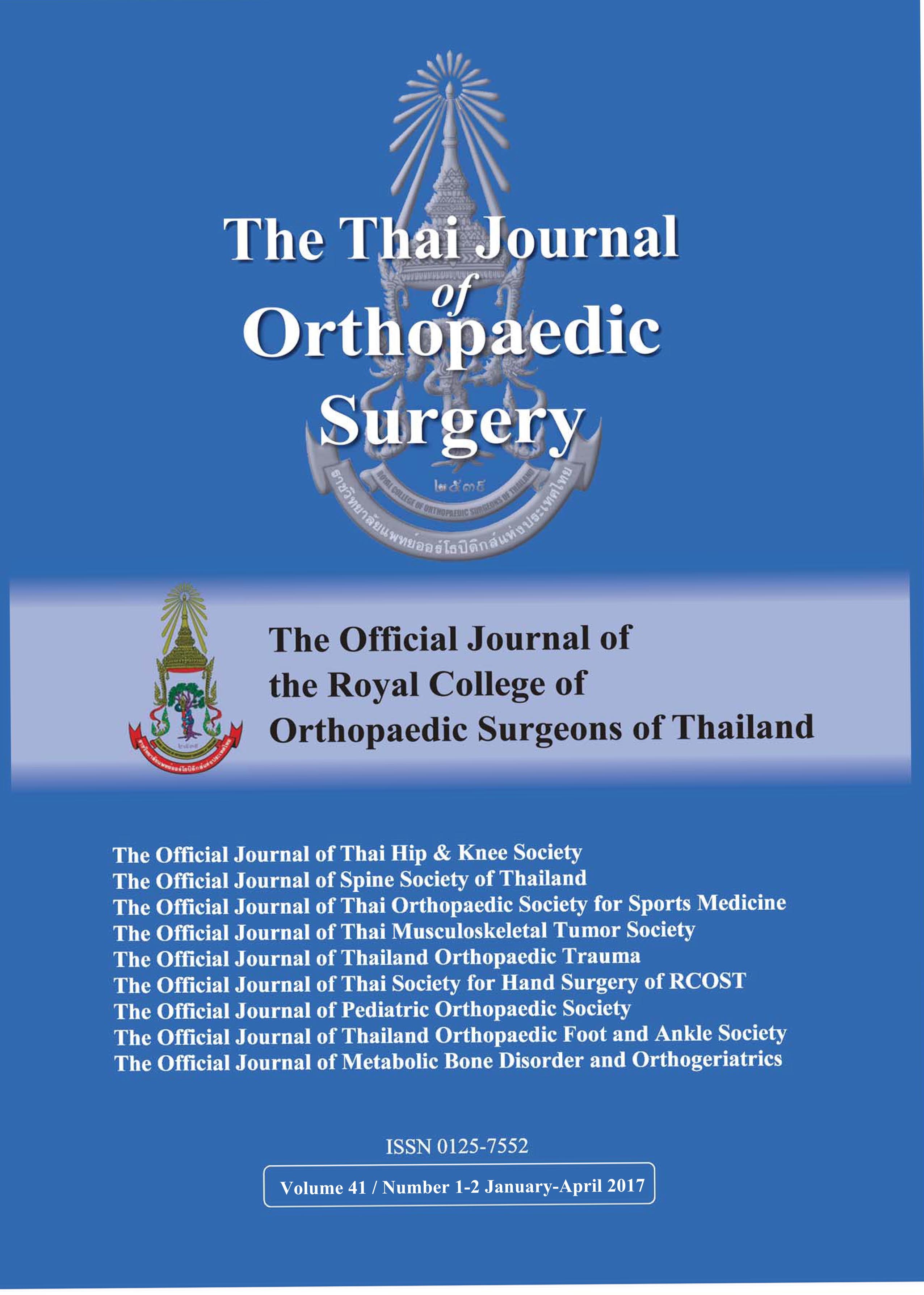Effects of Two Different Femoral Referencing Systems in Total Knee Arthroplasty on Immediate to Early Clinical Outcomes
Main Article Content
Abstract
Purpose: Basically, there are two different femoral referencing systems in total knee arthroplasty (TKA): anterior referencing system (ARS) and posterior referencing system (PRS). Selected femoral component based on ARS or PRS for individual patient, especially in-between size, which provide good knee kinematics and well soft tissue balance is among one of the surgical goals. However, there are few reports on advantages, disadvantages and clinical outcomes of TKA using both femoral referencing systems. We prospectively evaluated the effect of both femoral referencing systems in TKA on immediate to early clinical outcomes.
Methods: Eighty-one patients who had uncomplicated primary unilateral TKA were randomly divided into 2 groups; the ARS group and the PRS group, respectively. All patients underwent similar surgical techniques and postoperative protocol, except the step of femoral sizing according to the ARS group and the PRS group. Knees with measured in-between size of the femoral component were chosen a smaller size in the ARS group and a larger size in the PRS group. Patients were evaluated and compared to range of motion (ROM), visual analog scale (VAS), quadriceps peak torque (QPT), the Knee Society System (KSS) score and Short Form- 36 (SF-36) score, preoperatively, and at 2-week, at 6-week, at 3-month and at 6-month follow-up (FU).
Results: There were 61 females and 20 male patients with the average age and BMI of 70.6 years and 27.8 Kg/m2, respectively. Forty-o\ne patients and 40 patients were in the ARS group and the PRS group respectively. Sixteen patients in the ARS group and 17 patients in the PRS group had in-between size of the femoral component. All patients had gradually improved knee ROM, VAS, QPT, KSS score, and SF-36 at all FU visits with significant differences at 6-month compared to preoperative evaluation. There were no statistical differences in all investigated parameters between the ARS group and the PRS group. Similar, at 6-month FU, there were no differences in all investigated parameters of the in-between size subgroup of ARS and PRS. There were no complications related to using both femoral referencing TKA systems.
Conclusion: Both ARS and PRS for TKA demonstrated no differences in ROM of the knee, VAS, QPT, KSS score, and SF-36 during follow-up to six months. The concept to select a smaller femoral size for ARS and a larger size for PRS did not provide clinical differences, especially in ROM and QPT at early FU. We concluded that both contemporary TKA knee systems provided similar early clinical outcomes, regardless of matched or in-between femoral size.
Article Details
References
2. Guidelines for the management of postoperative pain after total knee arthroplasty. Knee Surg Relat Res 2012; 24: 201-7.
3. Breugem SJ, Haverkamp D. Anterior knee pain after a total knee arthroplasty: What can cause this pain? World J Orthop 2014; 5: 163-70.
4. Kim YH, Park JW, Kim JS, Park SD. The relationship between the survival of total knee arthroplasty and postoperative coronal, sagittal and rotational alignment of knee prosthesis. Int Orthop 2014; 38: 379-85.
5. Bonner TJ, Eardley WG, Patterson P, Gregg PJ. The effect of post-operative mechanical axis alignment on the survival of primary total knee replacements after a follow-up of 15 years. J Bone Joint Surg Br 2011; 93: 1217-22.
6. Lampe F, Marques CJ, Fiedler F, Sufi-Siavach A, Matziolis G. Do well-balanced primary TKA patients achieve better outcomes within the first year after surgery?. Orthopedics 2016; 39 Suppl 3: S6-12.
7. Matsumoto T, Muratsu H, Kubo S, Matsushita T, Kurosaka M, Kuroda R. Soft tissue tension in cruciate-retaining and posterior-stabilized total knee arthroplasty. J Arthroplasty 2011; 26: 788-95.
8. Oh CS, Song EK, Seon JK, Ahn YS. The effect of flexion balance on functional outcomes in cruciate-retaining total knee arthroplasty. Arch Orthop Trauma Surg 2015; 135: 401-6.
9. Okamoto S, Okazaki K, Mitsuyasu H, Matsuda S, Iwamoto Y. Lateral soft tissue laxity increases but medial laxity does not contract with varus deformity in total knee arthroplasty. Clin Orthop Relat Res 2013; 471: 1334-42.
10. Fokin AA, Heekin RD. Anterior referencing versus posterior referencing in total knee arthroplasty. J Knee Surg 2014; 27: 303-8.
11. Tanavalee A, Thiengwittayaporn S, Ngarmukos S. Rapid ambulation and range of motion after minimally invasive total knee arthroplasty. J Med Assoc Thai 2004; 87 Suppl 2: S195-201.
12. Berth A, Urbach D, Awiszus F. Improvement of voluntary quadriceps muscle activation after total knee arthroplasty. Arch Phys Med Rehabil 2002; 83: 1432-6.
13. Mizner RL, Petterson SC, Stevens JE, Vandenborne K, Snyder-Mackler L. Early quadriceps strength loss after total knee arthroplasty. The contributions of muscle atrophy and failure of voluntary muscle activation. J Bone Joint Surg Am 2005; 87: 1047-53.
14. Santic V, Legovic D, Sestan B, Jurdana H, Marinovic M. Measuring improvement following total hip and knee arthroplasty using the SF-36 Health Survey. Coll Antropol 2012; 36: 207-12.
15. Kiebzak GM, Vain PA, Gregory AM, Mokris JG, Mauerhan DR. SF-36 general health status survey to determine patient satisfaction at short-term follow-up after total hip and knee arthroplasty. J South Orthop Assoc 1997; 6: 169-72.
16. Manson TT, Khanuja HS, Jacobs MA, Hungerford MW. Sagittal plane balancing in the total knee arthroplasty. J Surg Orthop Adv 2009; 18: 83-92.
17. Faris PM, Ritter MA, Keating EM. Sagittal plane positioning of the femoral component in total knee arthroplasty. J Arthroplasty 1988; 3: 355-8.
18. Stan G, Orban H, Gruionu L, Gheorghe P. Coronal malposition effects in total knee arthroplasty: a finite element analysis. Eur J Orthop Surg Traumatol 2013; 23: 685-90.
19. Nandi S, Bono JV, Froimson M, Jones M, Bershadsky B. Effect of surgeon experience on femoral component size selection during total knee arthroplasty. J Surg Orthop Adv 2013; 22: 118-22.
20. Berend ME, Small SR, Ritter MA, Buckley CA, Merk JC, Dierking WK. Effects of femoral component size on proximal tibial strain with anatomic graduated components total knee arthroplasty. J Arthroplasty 2010; 25: 58-63.


